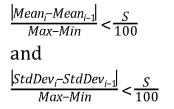Convergence Criteria in MOGA-Based Multi-Objective Optimization
Convergence criteria are the conditions that indicate when the optimization has converged. In the Multi-Objective Genetic Algorithm (MOGA)-based multi-objective optimization methods, the following convergence criteria are available:
Maximum Allowable Pareto Percentage
The Maximum Allowable Pareto Percentage criterion looks for a percentage that represents a specified ratio of Pareto points per Number of Samples Per Iteration. When this percentage is reached, the optimization is converged.
Convergence Stability Percentage
The Convergence Stability Percentage criterion looks for population stability, based on mean and standard deviation of the output parameters. When a population is stable with regards to the previous one, the optimization is converged. The criterion functions in the following sequence:
- Population 1: When the optimization is run, the first population is not taken into account. Because this population was not generated by the MOGA algorithm, it is not used as a range reference for the output range (for scaling values).
- Population 2: The second population is used to set the range reference. The minimum, maximum, range, mean, and standard deviation are calculated for this population.
- Populations 3 – 11: Starting from the third population, the minimum and maximum output values are used in the next steps to scale the values (on a scale of 0 to 100). The mean variations and standard deviation variations are checked. If both of these are smaller than the value for the Convergence Stability Percentage property, the algorithm is converged.

At each iteration and for each active output, convergence occurs if:

Where:
S=Stability Percentage
Meani= Mean of the i-th Population
StdDevi = Standard Deviation of the i-th Population
Max = Maximum Output Value calculated on the first generated population of MOGA
Min = Minimum Output Value calculated on the first generated population of MOGA
